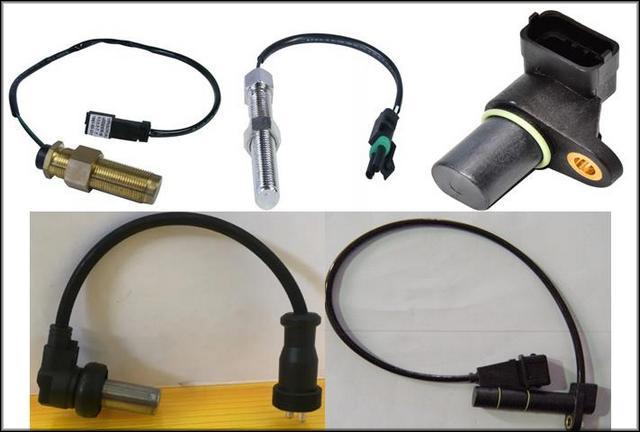
How to control the RPM sensor to get the best performance from your car
Content
An automobile tachometer or tachometer shows the speed of rotation of the engine. Keep an eye on the RPM sensor to improve your vehicle's performance and fuel efficiency.
When you start your car, the crankshaft inside the engine starts to rotate. The engine pistons are connected to the crankshaft and they rotate the crankshaft by moving up and down. Each time the crankshaft rotates 360 degrees, it is called a revolution.
RPM or revolutions per minute refers to how fast the engine is spinning. The internal components of your engine are moving so fast that it's hard to keep track of the RPM by hand. For example, when idling, your engine makes 10 or more revolutions per second. For this reason, cars use tachometers or rev sensors to keep track of revs.
Knowing engine speed is important for:
- Decide when to shift gears on a manual transmission
- Increase your vehicle's mileage by shifting gears at the correct RPM level.
- Determine if your engine and transmission are working properly
- Drive your car without damaging the engine.
Tachometers or RPM gauges show RPM in multiples of 1,000. For example, if the tachometer needle is pointing at 3, that means the engine is spinning at 3,000 rpm.
The highest rev range at which you start to run the risk of serious damage to your car's engine is called The red line, marked in red on the speed sensor. Exceeding the engine redline can cause significant engine damage, especially for extended periods of time.
Here's how you can use a tachometer or rev gauge to operate your car safely.
Method 1 of 3: Shift Manual Transmission Smoothly
If your car is equipped with a manual transmission, you can use the rev sensor to smoothly change gears and prevent the car from stalling.
Step 1. Accelerate from a standstill, controlling the speed. If you try to accelerate from a standstill without revving the engine, you will most likely stall the engine.
Increase the idle speed to 1300-1500 rpm and only then release the clutch pedal to smoothly accelerate from a standstill.
- Functions: With a manual transmission, you can continue driving from a standstill in first gear without even pressing the accelerator pedal. From a standstill, release the clutch pedal very slowly, making sure that the rpm does not drop below 500. Once your car starts moving, you can press the accelerator pedal to increase speed, although this may be a little jerky at first. .
Step 2: Use the RPM sensor to determine when to upshift.. When you accelerate in a manual transmission car, you need to eventually upshift in order to continue accelerating.
- Attention: When accelerating lightly, shift to the next higher gear when the engine speed is about 3,000 rpm. When accelerating hard, upshift when the rev gauge reads around 4,000-5,000 rpm.
Step 3: Use the rev sensor to downshift. When you need to slow down in a manual transmission car, you can monitor the RPM to determine when to downshift smoothly.
Depress the clutch and bring the engine up to the speed at which you would normally downshift.
Shift to the next lower gear, then slowly release the clutch to engage the gear. You will be in the upper gear range and can safely slow down by relieving pressure on the accelerator pedal.
Method 2 of 3: Check Transmission Operation Using RPM
Using the RPM sensor, you can determine if your car's engine and transmission are working properly.
Step 1: Control idle speed.
Watch the tachometer while your vehicle is idling and look for the following signs or symptoms.
- FunctionsA: If the RPM is very high when your vehicle is idling, it is recommended to call a certified mechanic, such as AvtoTachki, to have a look and fix the problem.
Step 2: Control rpm at a constant speed. You may need to drive at a fixed speed and watch for any unusual sounds or signs of trouble.
Method 3 of 3: Safe Engine Operation
Each engine has a manufacturer's recommended RPM range for safe operation. If you exceed these RPMs, you may experience internal engine failure or damage.
- Functions: Refer to your vehicle's owner's manual or the vehicle manufacturer's website to find the recommended RPM range for your specific make and model of your vehicle. You can also search online to find the recommended maximum RPM range for your engine.
Step 1: Watch the RPM Gauge and Avoid RPM Spikes. When accelerating, shift to the next gear before the needle of the engine speed sensor enters the red line zone.
If your car's engine oscillates while accelerating, it should be inspected by a mechanic, as this can be dangerous in situations where acceleration may be necessary, for example.
- Attention: Don't worry if you accidentally raise the RPM to the red line. While not recommended, it won't usually damage the engine if you adjust the RPM quickly.
Step 2: Downshift one gear at a time. If you shift more than one gear at a time, you may accidentally put the RPM in the redline area.
Step 3: Avoid Hard Acceleration. If possible, try to avoid hard or sudden accelerations to high speeds to prevent damage to the engine due to over-revving.
Step 4: Maintain fuel efficiency. For best fuel economy, keep the RPM between 1,500 and 2,000 rpm while driving at a constant speed.
- Attention: Your engine burns more fuel at higher RPMs.
Your RPM sensor is designed to help you drive more efficiently and prevent engine damage while driving. Keep an eye on the RPM and follow the recommended shifting methods to get the most out of your vehicle.
